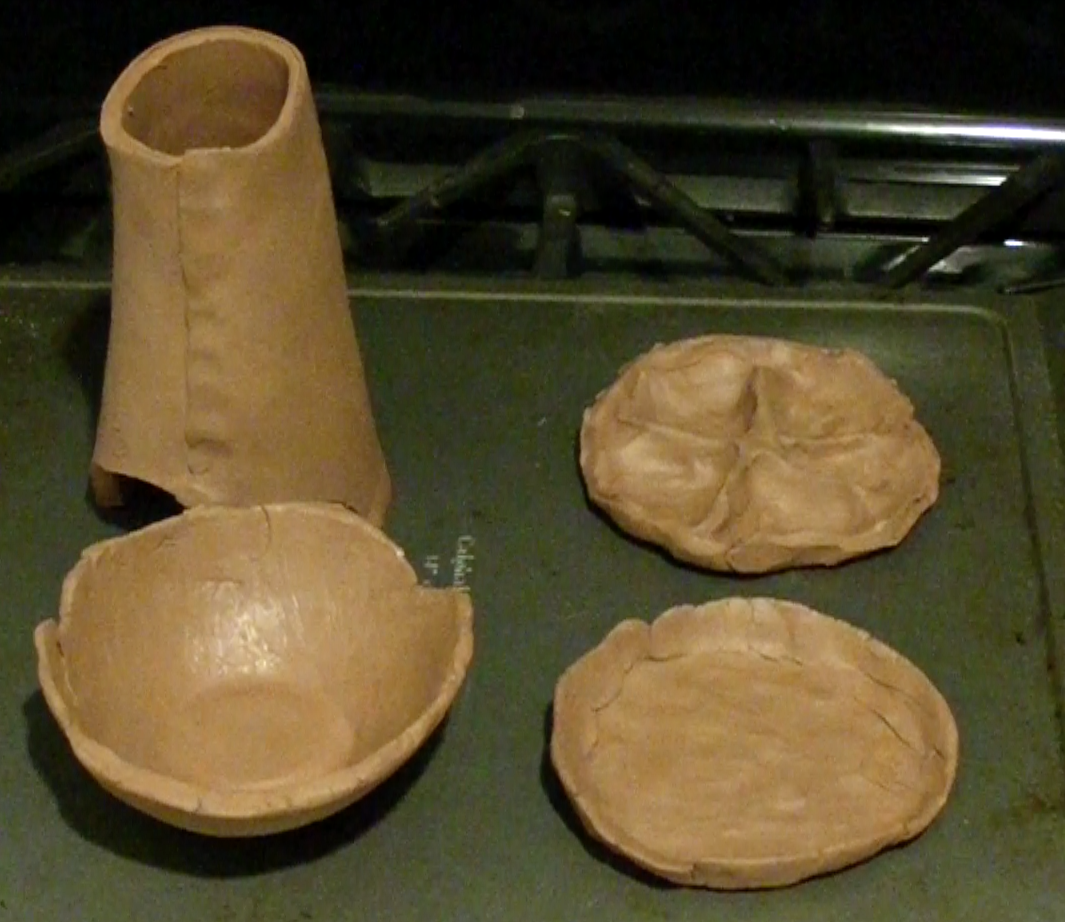Table of Contents
DATE AND TIME: 301730 Jan 15
LOCATION: 20th floor Apartment - Brooklyn, NY
SUBJECT: Historical Recipe Reconstruction - Pour faire les millas (p020r)
- Conditions:
- Approx. 70°, no air movement, 40% humidity.
- Equipment:
- Wooden cutting board: No anticipated effect on authenticity.
- Serrated knife: No anticipated effect on authenticity.
- Mixing bowls: No anticipated effect on authenticity.
- Measuring spoons: No anticipated effect on authenticity.
- Mortar and Pestle: Used to grind the millet. No anticipated effect on authenticity.
- Oven: Used to cook millas. Not an early modern cooking environment, but had to be used due to safety concerns.
- Cheese cloth: No anticipated effect on authenticity.
- Materials:
- Millet: No anticipated effect on authenticity.
- Water: No anticipated effect on authenticity.
- Eggs: No anticipated effect on authenticity.
- Terracotta: Used to make molds for shaping millas. No anticipated effect on authenticity.
- Discussion on Procedure:
- The recipe states "You must have some millet soaked in order to remove the chaff and then clean it well" (p020r). The millet we bought was preprepared for cooking. It had already been cleaned from chaff and removed from the stalk. It is unknown how soaking during the cleaning process would have affected the taste of the millas. This could be tested with actually obtaining some raw millas.
| Whole Millet bought at a local market. |
- The millet was ground with mortar and pestle. The Millet was extremely difficult to grind and only yielded about a cup of flour after 1 hour of grinding. It is more than likely that the practitioner had a grinder that would have saved the labor. We ground around three cups of flour and sifted it through three layer of cheese cloth.
- The recipe states "Afterwards you must have some molds, which must be made from terra[cotta], like a furnace for catholic hats but it must be open at both ends. And then, having made a good fire, clean where you want to put your millas and then take your molds and grease them very well so that the pastry does not stick to them when baked. Once you have done that, put your molds in a place in the oven where you clean and sprinkle a bit of flour on the bottom and fill them with some of the aforementioned pastry. Then you will cover the said molds, with a lid made like the mould, but it must be bigger and not open at the top" (p020r). This portion of the recipe was not clear. It was clear that we should have molds, but there was discussion about how the phrase 'like a furnace for catholic hats' fit into the recipe, or how a lid was 'open at both ends.'
- In order to test the phrasing we decided to perform three different iterations of the experiment. First was a mini furnace that would mimic a catholic hat, or as close as we could get. The second was for a mold that could shape the millas into bite-sized biscuit and will be cooked without a lid. The third was a covered mold for a larger milas cake.
 |
| Our molds. |
| Terracotta Clay, self-drying or could be cooked in a kiln. |
- The terracota molds were molded and left overnight to dry.
NAME: Jef Palframan and Giulia Chiostrini
DATE AND TIME: 011730 Feb 15
LOCATION: 20th floor Apartment - Brooklyn, NY
SUBJECT: Historical Recipe Reconstruction - Pour faire les millas (p020r)
- Conditions:
- Approx. 69°, no air movement, 45% humidity.
- Equipment
- Wooden cutting board: No anticipated effect on authenticity.
- Serrated knife: No anticipated effect on authenticity.
- Mixing bowls: No anticipated effect on authenticity.
- Measuring spoons: No anticipated effect on authenticity.
- Mortar and Pestle: Used to grind the millet. No anticipated effect on authenticity.
- Oven: Used to cook millas. Not an early modern cooking environment, but had to be used due to safety concerns.
- Cheese cloth: No anticipated effect on authenticity.
- Materials:
- Millet: No anticipated effect on authenticity.
- Eggs: No anticipated effect on authenticity.
- Butter: Not authentic to early modern butter. Best that could be done without increased cost or a larger amount of time.
- Milk: 1% Organic, pasteurized. Not authentic to early modern milk.
- Terracotta: Used to make molds for shaping millas. No anticipated effect on authenticity.
- Discussion on Procedure:
- Like other early modern recipes the quantities are not specified in the recipe from the Ms. Because the Ms. states that the dough should be light like "the pastry to make beignets", we decided to utilize a contemporary recipe for beignets to estimate the amounts. The recipe can be found at:http://ricette.giallozafferano.it/Pasta-per-choux.html
- The millet flour was sifted again. Three cups of millet flour were combined with three Tbs of melted butter, 1 cup of milk, and 2egg yolks in a mixing bowl.
- The mixture was whipped until it was very light and pastry like as indicated in the recipe.
- Lard was applied to the terracotta mold to "grease them very well" (p020r) and filled with the mixture. The molds were placed in the oven, and baked at 350°F for 40 mins.
- The results of the experiment were less than appetizing. The millas smelt nice, but had a bitter aftertaste. The molds worked well and it would be possible to mold some interesting shapes with the terracotta. The mold-ability and ornamentation of the recipe again suggests that the author was involved with displaying his works. It is also possible that the millas could not have been intended to be consumed and were another example of ornamentation.
- Since this recipe will be attempted again in preparation for writing an annotation, we will vary the mixture during the next attempt. We may try less milk, more butter, and more egg yolks.
- More information can be found in the presentation below: